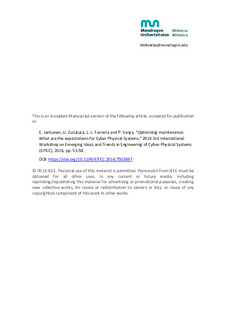Title
Optimising Maintenance: What are the expectations for Cyber Physical SystemsAuthor
xmlui.dri2xhtml.METS-1.0.item-contributorOtherinstitution
https://ror.org/04988re48https://ror.org/02w42ss30
https://ror.org/04b181w54
Version
http://purl.org/coar/version/c_ab4af688f83e57aa
Rights
© 2016 IEEEAccess
http://purl.org/coar/access_right/c_abf2Publisher’s version
https://doi.org/10.1109/EITEC.2016.7503697Published at
Proceedings of the 3rd International IFIP Workshop on Emerging Ideas and Trends in Engineering of Cyber-Physical Systems (EITEC’16) Vienna. 11 April. Pp. 53-58. IEEE, 2016Publisher
IEEEKeywords
Wear
condition monitoring
condition-based maintenance
Sensors ... [+]
condition monitoring
condition-based maintenance
Sensors ... [+]
Wear
condition monitoring
condition-based maintenance
Sensors
signal analysis
diagnosis
prognosis
cyber physical systems [-]
condition monitoring
condition-based maintenance
Sensors
signal analysis
diagnosis
prognosis
cyber physical systems [-]
Abstract
The need for maintenance is based on the wear of components of machinery. If this need can be defined reliably beforehand so that no unpredicted failures take place then the maintenance actions can be ... [+]
The need for maintenance is based on the wear of components of machinery. If this need can be defined reliably beforehand so that no unpredicted failures take place then the maintenance actions can be carried out economically with minimum disturbance to production. There are two basic challenges in solving the above. First understanding the development of wear and failures, and second managing the measurement and diagnosis of such parameters that can reveal the development of wear. In principle the development of wear and failures can be predicted through monitoring time, load or wear as such. Monitoring time is not very efficient, as there are only limited numbers of components that suffer from aging which as such is result of chemical wear i.e. changes in the material. In most cases the loading of components influences their wear. In principle the loading can be stable or varying in nature. Of these two cases the varying load case is much more challenging than the stable one. The monitoring of wear can be done either directly e.g. optical methods or indirectly e.g. vibration. Monitoring actual wear is naturally the most reliable approach, but it often means that additional investments are needed. The paper discusses the above issues and what are the requirements that follow from these for optimising maintenance based of the use of Cyber Physical Systems. [-]






















